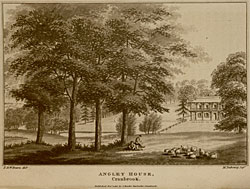|
Notes l Bibliography l Download Issue 7 
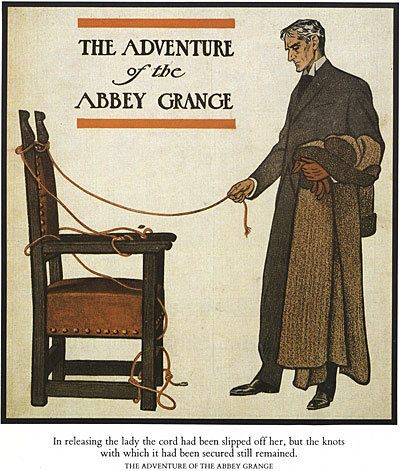 |
|
Frederic Dorr Steele made this beautiful cover illustration for the American magazine Collier's Weekly (December 1904). |
"The Adventure of the Abbey Grange" (1)
This story takes place in 1897, before Holmes's "death," but was published in 1904.
A "grange" is a medieval farm or grain storage building, often belonging to a religious order. "Abbey Grange" must be an historical name for the grounds on which Sir Eustace's house was built.
"Come, Watson, come!" he cried. "The game is afoot. Not a word! Into your clothes and come!" (1)
This is the most famous of all Sherlockisms.
...on our way to Charing Cross Station. (1)
Charing Cross Station, located near Trafalgar Square, is the correct station for catching a train to Kent, southeast of London.
...blurred and indistinct in the opalescent London reek. (1)
The famous London fogs of years ago, so dear to mystery readers' hearts, have today disappeared completely. Far from being simple fog, they were composed of pollution from the burning of bituminous coal (hence the "reek," and the often-used epithet "greasy"). A temperature inversion, when a stable layer of cold air stalled over the warm city miasma, could make the fog immovable for days. In 1952, when a particularly bad fog resulted in hundreds of fatalities, mainly among people with respiratory weaknesses, the government finally took action to prevent the burning of soft coal.
"Abbey Grange, Marsham, Kent...." (1)
Kent is a county located just southeast of London. There is no town named "Marsham" in Kent.
"Hopkins has called me in seven times, and on each occasion his summons has been entirely justified," said Holmes. (1)
Hopkins also appears in "The Golden Pince-Nez" (The Strand, July 1904), "Black Peter" (March 1904), and "The Missing Three-Quarter" (August 1904), three cases preceding "The Abbey Grange." Watson apparently never wrote up the other four cases.
"Why do you not write them yourself?" I said, with some bitterness.
"I will, my dear Watson. I will." (3)
Holmes criticizes Watson's writing several times in the stories. He does eventually decide to write two cases himself: "The Blanched Soldier" (The Strand, November 1926) and "The Lion's Mane" (December 1926). In the judgment of most readers, Watson does a better job of narration.
The ideas of my friend Watson, though limited, are exceedingly pertinacious. For some time he has worried me to write an experience of my own, since I have often had occasion to point out to him how superficial are his own accounts and to accuse him of pandering to popular taste instead of confining himself rigidly to facts and figures.
(From "The Lion's Mane")
"We are moving in high life, Watson; crackling paper, 'E.B.' monogram, coat-of-arms, picturesque address." (3)
"Cracking paper" probably means parchment, made from animal skin in Conan Doyle's time, but today mostly made from plant fiber. The Abbey Grange note paper that Inspector Stanley uses is of high quality, and is imprinted with Sir Eustace's monogram and his family coat of arms.
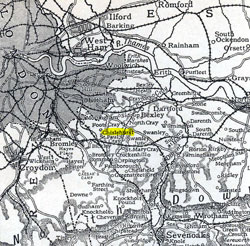 |
|
Chislehurst can be seen slightly to the southeast of London just off one of the main rail lines. From Thomas Downes Wilmot Dearne, An Historical and Topographical Descriptive Account of the Weald of Kent (Cranbrook, 1814)
|
"...here we are at Chislehurst Station...." (3)
Located in the historic county of Kent, Chislehurst is today part of greater London.
The avenue ran through a noble park, between lines of ancient elms, and ended in a low, widespread house, pillared in front after the fashion of Palladio. (3)
The greatest Italian architect of the 16th-century, Andrea Palladio (1508-1580) influenced western architecture for centuries with his classical revival style. Palladio's buildings are characterized by a central architectural element flanked by two lesser, symmetrical elements, and by the use of pillars. The English baroque style, from the early 18th century, is Palladian.
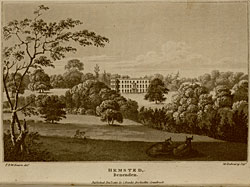 |
|
|
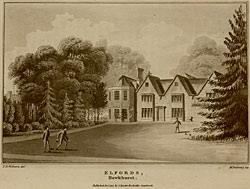 |
| Some stately homes in Kent, from Thomas Downes Wilmot Dearne, An Historical and Topographical Descriptive Account of the Weald of Kent (Cranbrook, 1814) |
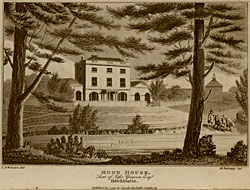 |
| Moor House has the most Palladian architectural elements of any of these homes. |
"You remember that Lewisham gang of burglars?" (3)
Lewisham is an inner borough of London.
"They did a job at Sydenham a fortnight ago...." (3)
A suburb of London, located mostly in the borough of Lewisham.
"I was brought up in the freer, less conventional atmosphere of South Australia, and this English life, with its proprieties and its primness, is not congenial to me." (3)
In English literature, women brought up in the colonies are often described as less conventional and more uninhibited than Englishwomen.
"To be with such a man for an hour is unpleasant. Can you imagine what it means for a sensitive and high-spirited woman to be tied to him for day and night? It is a sacrilege, a crime, a villainy to hold that such a marriage is binding. I say that these monstrous laws of yours will bring a curse upon the land–Heaven will not let such wickedness endure." (4)
Conan Doyle held strong views on the inequities of English divorce laws, which allowed a husband to divorce his wife for adultery, but only allowed the wife to divorce on such grounds if the adultery were accompanied by extreme physical cruelty. This diatribe sounds more like his voice than Lady Brackenstall's.
"...with his favourite blackthorn cudgel in his hand." (5)
The blackthorn is a native European shrub whose straight branches are often made into walking-sticks or clubs.
"...Miss Mary Fraser of Adelaide...." (5)
Adelaide is the largest city of Southern Australia.
His dark, handsome, aquiline features were convulsed into a spasm of vindictive hatred, which had set his dead face in a terribly fiendish expression. (6)
Contrary to popular opinion, a grimace on a corpse's face is not an indication of the person's mood just before death, but is caused by the progression of rigor mortis.
...and one of them containing some dregs of bees-wing. (7)
"Bees-wing" is a filmy substance, resembling an insect's wing, that is found in wines, such as port, which have been aged for many years.
"...one of these multiplex knives in his possession." (7-8)
A "multiplex" knife is a pocketknife with a variety of tools attached to it, such as a Swiss Army Knife.
"...had we approached the case de novo ...." (8)
That is, afresh, with no preconceptions (Latin).
"We have not yet met our Waterloo, Watson, but this is our Marengo, for it begins in defeat and ends in victory." (9)
Napoleon Bonaparte (1769-1821), self-proclaimed emperor of France, met his final defeat at Waterloo, Belgium, in 1815, and spent the rest of his life in exile. In the 1800 Battle of Marengo, at the start of Napoleon's rule of France, the Austrian army at first forced the French to fall back, but French reinforcements eventually carried the day.
"It may be a hit or it may be a miss, but we are bound to do something for friend Hopkins, just to justify this second visit," said he. "I will not quite take him into my confidence yet." (11)
Holmes is often wary of telling the police everything he knows, and yet, he "plays fair" with them by giving them enough hints to work out the solution. In Holmes's view, as long as justice is done, it does not necessarily have to involve the authorities.
"...the shipping office of the Adelaide-Southampton line, which stands at the end of Pall Mall...." (11)
A fictional transportation company running passengers and freight between Australia and England.
The boat was now on her way to Australia, somewhere to the south of the Suez Canal. (11)
One of the most important (and vulnerable) shipping lanes in the world, the Suez Canal (opened in 1869) connects the Red Sea with the Mediterranean Sea, cutting a 101-mile passageway through the bridge of land between the Sinai Desert and Egypt. Its construction is one of the most shameful episodes of 19th-century colonialism. Frenchman Ferdinand de Lesseps used the forced labor of Egyptian workers, many thousands of whom died during the 11-year construction. (Construction was complicated, involving the building of multiple locks, because the Mediterranean is lower than the Red Sea.) Without the canal, English ships would have to travel around the horn of Africa to get to the Far East or Australia.
"Once or twice in my career I feel that I have done more real harm by my discovery of the criminal than ever he had done by his crime. I have learned caution now, and I had rather play tricks with the law of England than with my own conscience." (12)
Holmes takes motive and circumstance into account when he decides whether to report a guilty person to the authorities. It would be easier to let the law take its course, but Holmes wrestles with his conscience instead of letting someone else take responsibility. But does he always do right when he frees a criminal? Such an act carries a risk, the consequences of which Holmes himself will not be forced to bear.
"...what I know is unofficial; what he knows is official...." (13)
Holmes does not feel obliged to report all that he knows to the authorities, but he feels that a person who works for the State does have such an obligation.
"I believe you are a man of your word, and a white man, and I'll tell you the whole story." (14)
Captain Croker seems to equate skin color with truthfulness and reliability—a not uncommon prejudice in Conan Doyle's time.
The picture of Captain Croker on page 14 of the text is one of Sidney Paget's most incongruous efforts. The man it shows entering the Baker Street study does not seem to be "a [fine] specimen of manhood," but simply a man in an ill-fitting coat.
"Not guilty, my lord," said I.
"Vox populi, vox Dei." (15)
"The voice of the people is the voice of God" is a proverb whose origins are unknown, first recorded in Charlemagne's time.
Holmes's court proceedings seem a bit cavalier, considering the gravity of the offense.
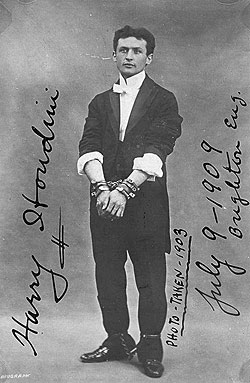 |
|
Harry Houdini loved to pose for pictures in evening dress and shackles, probably to exploit the sheer incongruity of the combination. Picture courtesy of the McManus-Young Collection, Library of Congress |
In 1848, in a small cottage in Hydesville, New York—an area of the state nicknamed "The Burned-Over District" for the many evangelical religions it had spawned—two young sisters started a religious movement that would influence thousands around the world. Kate and Margaret Fox's apparent ability to communicate with the dead created the Spiritualist movement, and started a craze for séances, complete with spirit rapping, table-turning, manifestations of ectoplasm, and mysterious touches in the darkness. Late in life, they confessed that it had all been a hoax.
Celebrated escape artist and magician Harry Houdini (1874-1926), an old hand at fooling the public eye, detected in the performances of "mediums" many tricks borrowed from his trade. Joining with the Scientific American, which offered $2,500 for anyone who could produce a genuine spirit visitation, he set about debunking mediums, using the resulting scandals as a ready-made source of publicity.
Sir Arthur Conan Doyle was at the other end of the spectrum. Long interested in spiritualism, his interest grew after the death of his beloved son Kingsley in World War I. At first, he professed skepticism, claiming to believe only in "reputable" mediums. He styled himself an investigator of paranormal phenomena, and claimed to have excellent powers of observation (like his creation, Sherlock Holmes). From this claim followed his conviction that, if he did not observe trickery at a séance, it must have been genuine.
Against all probability, Houdini and Conan Doyle became friends for a time.
More in the next issue....
|





